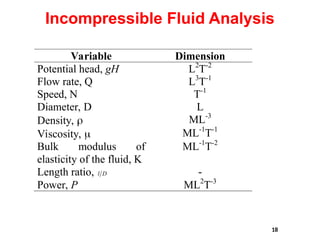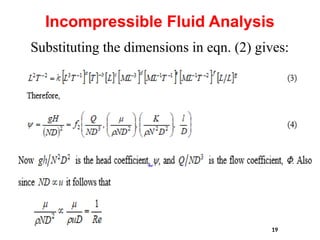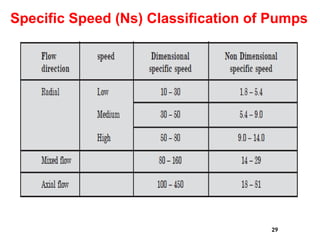Performance Characteristics of Hydraulic Machines Vol 1.pptx
- 1. MC 371 Hydraulic Machinery Dr. Clement A. Komolafe [email protected] Recommended textbook Fluid Machinery: Application, Selection and Design by Wright T. and Gerhart P.M.
- 2. Lecture content 2 PERFORMANCE CHARACTERISTICS OF TURBOMACHINES Dimensional Analysis and Similarity for Turbomachinery: Dimensionality Similitude Dimensionless numbers and -products Dimensionless performance variables and similarity for turbomachinery Specific speed and specific diameter
- 3. 3 Introduction • Two flow parameters that are very important in all turbomachines are: - Flow rate (Q) and, - Head (H). • Mechanical quantities associated with the machines are the - Power (P), - Speed (N), - Size (D) and - Efficiency ()
- 4. 4 Introduction The output of a pump running at a given speed is the flow rate delivered and the head developed. Plot of head (H) versus flow rate (Q) at constant speed (N) forms the fundamental performance characteristic of a pump. Plots of power input required (P) and efficiency () versus flow rate Q is also useful. Typical pump performance characteristic at a particular speed, N: H vs. Q for various values of N P vs. Q vs. Q
- 5. 5 Introduction In the case of turbines, the output is power developed (P) at a given speed (N). Fundamental turbine characteristic consists of a plot of: Power (P) against speed (N) at constant head (H), Power (P) against flow rate (Q) and Efficiency () versus speed (N) is also useful. Performance characteristics are the relationships between variables relevant to hydraulic machine in graphical form. Performance characteristics are determined experimentally by performances tests. The performance characteristic differs for different design features and different sizes.
- 6. 6 Dimensional Analysis It is a mathematical technique which makes use of the study of the dimensions for solving several engineering problems. Each physical phenomenon can be expressed by an equation which defines the given relation and dimensions, which can be non- dimensionalized. Uses of dimensional analysis 1. To test the dimensional homogeneity of any equation of fluid motion. 2. To derive rational formula for a flow phenomenon. 3. To derive equation expressed in terms of non-dimensional parameters. 4. To plan model test and present experimental results in a systematic manner, it makes it possible to analyse the complex fluid flow problem.
- 7. 7 Dimensional Analysis Advantages of dimensional analysis 1. It expresses the fundamental relationship between the variables in dimensionless terms. 2. By the proper selection of variables, the dimensionless parameters can be used to make certain logical deduction about the problem. 3. It enables getting a theoretical equation in a simplified dimensional form. 4. Dimensional analysis provides partial solution to the problems that are too complex to be dealt with mathematically. 5. The conversion of units of quantities from one system to another is facilitated.
- 8. 8 Dimensional Analysis Dimensions The various physical quantities using fluid phenomenon can be expressed in terms of fundamental quantities which include; mass, length, time and temperature, designated by the letters M, L, T and respectively. Dimensionless Groups for Turbomachines Performance There are three methods to obtain dimensionless groups: 1. Dimensional analysis, 2. Dynamic similarity, 3. Non-dimensionalization of relevant differential equation.
- 9. The concept of dimensional analysis (DA) i. is closely linked to the principle of dimensional homogeneity, ii. is important for the correct design of experiments, and iii. helps in the extraction of maximum possible information from a large number of test data. Applying the concept of dimensional analysis to turbomachines i. provides a greater depth of understanding to the performance and classifications of machines, ii.allows the extrapolation of performance data from one operating condition to another, and iii.clarifies the fundamental reasons behind wide configuration difference in machines. DIMENSIONALITY 9 Ultimately, one can save a lot of time and money during designing, testing and analysis in turbomachinery by DA.
- 10. The principle of dimensional homogeneity states that if an equation correctly represents a relationship between variables in a physical process, it will be homogeneous in dimensions. That is each term will add to the other terms only if they are all of like dimensions. PRINICIPE OF DIMENSIONAL HOMOGENEITY 10 Consider the familiar Bernoulli equation for a steady, incompressible, frictionless flow without any shaft work (Eq. 1). 𝑝+𝜌 𝑉 2 2 +𝜌 𝑔𝑧=𝑝0 (1) Thermodynamic (or static) pressure Dynamic pressure Hydrostatic pressure Stagnation (or total) pressure
- 11. The concept of similitude allows the variables of problems to be arranged into dimensionless groups also called dimensionless numbers. SIMILITUDE OR PRINICIPE OF SIMILARITY 11 The case of a gas flow in which the hydrostatic term is negligible for Bernoulli equation may be grouped into a dimensionless number (Eq. 2) 𝑝0 −𝑝 1/2 𝜌 𝑉 2 =1 (2) Eq. 2 is known as the pressure coefficient. The principle of similarity is used in relating information obtained from the test of a model to the information that would pertain to the full scale device, often called the prototype. For this to happen there must be geometric similarity, kinematic similarity and dynamic similarity. A model and a prototype are geometrically similar if all physical or body dimensions in all three (Cartesian) axes have the same linear ratio
- 12. SIMILITUDE OR PRINICIPE OF SIMILARITY 12 Finally for dynamic similarity, the ratios of forces, masses, and energies must be equal between a model and a prototype, presupposing geometric and kinematic similarities. For kinematic similarity, the motions of two systems are kinematically similar if similar elements lie at similar locations and similar times. Geometric similarity is a precondition for kinematic similarity. Similarity study ensures the accurate prediction of the performance or behavior of one object (or machine or test) from information about the performance of a similar object under a different set of conditions (e.g., size, speed, and fluid involved) Complete similarity is required for the above to take place but in practice it is frequently impracticable to achieve.
- 13. The basis for any similarity analysis is a set of dimensionless numbers, formed from the problem variables, that adequately describe the phenomenon under study. These numbers are determined by dimensional analysis. There are at least four methods of forming the dimensionless numbers they include: i. adapting “standard” dimensionless numbers (e.g. Re and Mach nos.), ii. by inspection, iii.by non-dimensionalising the governing equations, and iv.using the П-product method. Let’s review the П-product method The objective is to form products from the problem variables that will yield new dimensionless variables that are fewer in number compared to the original list. DIMENSIONLESS NUMBERS AND -PRODUCTS 13
- 14. Consider the lift force on an airfoil, which may represent a simple model of a compressor or a turbine blade (Fig 1). DIMENSIONLESS NUMBERS AND -PRODUCTS 14 Fig 1: Lift on an airfoil The steps are as follows 1) List and count the variables () 2) List and count the fundamental units or dimensions () 3) Select a number of variables as “primary” 4) Form П- products from the primaries plus a remaining variable.
- 15. The flow rate is listed first because it is the primary independent variable. is included as reminder that geometric similitude is imposed. The dimensionless ratio, (relative roughness) , has been omitted for the time being. DIMENSIONLESS PERFORMANCE VARIABLES AND SIMILARITY FOR TURBOMACHINERY (INCOMPRESSIBLE FLOW) 15 The performance of a turbomachine in an incompressible flow may involve the following variables: o Q: volume flow rate [] o gH: head (specific energy variable) [] (gH = ) o P: power [] o N: rotational speed [] o D: diameter [L] o : density [] o : fluid viscosity [] o : diameter ratio (dimensionless) How many dimensionless parameters can the above list be reduced to?
- 16. Incompressible Fluid Analysis Let the turbomachine be a pump or a hydraulic turbine Control variable: Q = flow rate, N = speed of motor Fluid properties: = fluid properties m= viscosity Geometric Variables: D = Impeller diameter, • K = bulk modulus of elasticity of the fluid
- 17. 17 Incompressible Fluid Analysis We can take the net energy transfer per unit mass flow rate gH, the efficiency, , and power supplied P, as dependent variables. The relationship between the specific energy (head developed) as the dependent variable and other independent variables is:
- 18. 18 Incompressible Fluid Analysis Variable Dimension Potential head, gH L2 T-2 Flow rate, Q L3 T-1 Speed, N T-1 Diameter, D L Density, ML-3 Viscosity, ML-1 T-1 Bulk modulus of elasticity of the fluid, K ML-1 T-2 Length ratio, D l - Power, P ML2 T-3
- 19. 19 Incompressible Fluid Analysis Substituting the dimensions in eqn. (2) gives:
- 20. 20 Incompressible Fluid Analysis Similarly, if the efficiency and power are taken as the dependent variable the relationship between the variables may be written as
- 22. 22 Incompressible Fluid Analysis In addition to pressure coefficient, the coefficients popularly used in model testing are given below:
- 23. 23 Similarity (Affinity) Laws For all machines belonging to one family of geometrically similar machines, the dimensionless parameters are the same at corresponding points of their characteristics (dynamic similarity). Since These laws allow us to predict the performance of machine when N or D varied from a known performance curve. Dimensionless head H versus volume Q characteristics of a centrifugal pump
- 24. 24 Type Number or Specific Speed or Shape Number (Ns)
- 25. 25 Type Number or Specific Speed or Shape Number (Ns) At the point where efficiency is maximum for each type of turbomachine with fixed geometry we define for geometrically similar machines: For a pump, we may define the type number, Ns, as
- 26. 26 Type Number or Specific Speed or Shape Number (Ns) Note that Ns can be calculated at any point on the characteristic curve but such values have no practical interest and only the type number at the design point is called the specific speed. The specific duty is referred to as the design point, which is normally associated with the maximum efficiency of the machine. The specific speed at the design point is stated for pumps in terms of flow rate and head developed as:
- 27. 27 Recall: Type Number or Specific Speed or Shape Number (Ns) Dimensionless Specific Speed, Ns for Pump 4 3 2 1 2 3 max max gh NQ Ns (20) Dimensional Specific Speed, Nsp for Pump 4 3 H Q N N SP Dimensionless Specific Speed, Ns for Turbine 4 5 2 1 2 1 4 5 max 2 1 max gh NP P Nsp Dimensional Specific Speed, Nsp, for Turbine 4 5 H P N NST (21) (22) (23)
- 28. 28 Specific Speed (Ns) Classification of Turbine Best specific speed range for different type of hydraulic turbines
- 29. 29 Specific Speed (Ns) Classification of Pumps
- 30. 30 Type Number or Specific Speed or Shape Number (Ns) Thus, specific speed relates different types of pumps without reference to size. Broadly speaking, each different class of machine has its optimum efficiency within a fairly narrow range of specific speeds.
- 31. 31 Type Number or Specific Speed or Shape Number (Ns) Since, a higher specific speed implies a smaller machine, for reasons of economy, it desirable to select the highest possible specific speed consistent with good efficiency. With the aid of the type number, the various types of pumps and turbines may be classified and compared as shown in the adjacent figure.
- 32. 32 Type Number or Specific Speed or Shape Number (Ns)
- 33. 33 Example 1 Francis turbine is required to develop about 4.5 MW at maximum efficiency when running at 110 rev/min with a head of 14 m. A scale model is tested with a head of 3.7 m and at maximum efficiency, the speed was 210 rev/min, the flow rate was 1.45 m3 /s and the power output was 44.25 kW. Determine: (i) the ratio of sizes of turbine and model, (ii) the specific speed, (iii) the flow rate required through the turbine, (iv) the turbine power output, and (v) the turbine efficiency.
- 37. 37 Example 2 A quarter-scale turbine model is tested under a head of 11 m. The full-scale turbine is to use a head of 30 m and to run at 430 rev/min. At what speed should the model test be made? If, during the test, the model produces 100 kW at the point of maximum efficiency, using a flow of 1.08 m3 /s of water, what will be the power output of the full scale turbine and the flow rate required at the point of maximum efficiency?
- 40. Geometric similarity between a prototype car of length and a model car of length The geometric scale factor can be less than, equal to or greater than 1
- 41. Kinematic similarity is achieved when, at all locations, the speed in the model flow is proportional to that at corresponding locations in the prototype flow, and points in the same direction. Geometric similarity is a prerequisite for kinematic similarity.
- 42. Correlation of pump impeller shapes with specific speed and diameter
- 43. Cordier diagram for all types of turbomachines
Editor's Notes
- #9: Recall the study of dimensional analysis in fluid mechanics at 200 Level.
- #10: In Eq. 1 the dimensions of each term are that of pressure, i.e., they are all the same and thus they are often given the name related to pressure. Thermodynamic (or static) pressure , dynamic pressure, and hydrostatic pressure. The sum of which is equal to the stagnation (total) pressure. The dimensions of pressure are Force/Length2 [F/L2] or Mass/(Length Time2) [M/LT2]. The unit of pressure is N/m2 [Pa].
- #11: The principle of similarity follows from the principle of dimensional homogeneity. Note that the term on the left hand side of Eq. 2 has no dimensions or units and it is known as the pressure coefficient. Thus Bernoulli equation may be reduced to the simple statement that the pressure coefficient is constant. Geometric similarity implies that all length dimensions, all angles, all flow directions, all orientations, and even surface roughness heights must “scale”. In simple terms, the model must look exactly “like” the prototype.
- #12: By including time similarity, the elements of velocity and acceleration have been introduced. In fluid mechanics, kinematic similarity means the ratios of velocity (e.g., fluid velocity to blade velocity) and ratios of time scales (frequency or rotational speeds) must be equal. In general, dynamic similarity requires equality of the Reynolds number, Mach number, and Froude number. At times, equality of Weber number and/or cavitation will also be required. For instance, it is usually impossible to match both Reynolds and Mach numbers in testing an object for high-speed operation. Therefore once it is possible to achieve or maintain the same “regime” for both model and prototype, extrapolation of data is fairly accurate.
- #14: The objective is to form products from the problem variables that will yield new dimensionless variables that few in number compared to the original list. The steps are as follows List and count the variables () List and count the fundamental units or dimensions () Select a number of variables as “primary” (usually, this group consists of of the problem variables) Form П- products from the primaries plus a remaining variable. Once one obtains () new dimensionless varaibles, the variable list is reduced by .
- #15: is included as reminder that geometric similitude is imposed, thus eliminating changes of shape or proportion.














![ The flow rate is listed first because it is the primary independent
variable.
is included as reminder that geometric similitude is imposed.
The dimensionless ratio, (relative roughness) , has been omitted for
the time being.
DIMENSIONLESS PERFORMANCE VARIABLES AND SIMILARITY
FOR TURBOMACHINERY (INCOMPRESSIBLE FLOW)
15
The performance of a turbomachine in an incompressible flow may
involve the following variables:
o Q: volume flow rate []
o gH: head (specific energy variable) [] (gH = )
o P: power []
o N: rotational speed []
o D: diameter [L]
o : density []
o : fluid viscosity []
o : diameter ratio (dimensionless)
How many dimensionless
parameters can the above
list be reduced to?](https://image.slidesharecdn.com/performancecharacteristicsofhydraulicmachinesvol1-241006233318-ab51a2c1/85/Performance-Characteristics-of-Hydraulic-Machines-Vol-1-pptx-15-320.jpg)



























